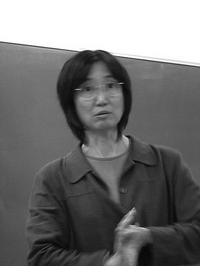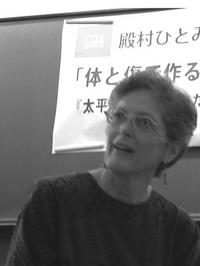
 On October 21, 2004, a joint symposium was held at ICU with Professors Anne Walthall and Hitomi Tonomura. It was conducted in a friendly, relaxed atmosphere, which enabled a lively exchange of ideas and opinions by both presenters and participants. The discussion between Professors Walthall and Tonomura unfolded to reveal an entirely different picture of Japanese history to that which I had known so far.
On October 21, 2004, a joint symposium was held at ICU with Professors Anne Walthall and Hitomi Tonomura. It was conducted in a friendly, relaxed atmosphere, which enabled a lively exchange of ideas and opinions by both presenters and participants. The discussion between Professors Walthall and Tonomura unfolded to reveal an entirely different picture of Japanese history to that which I had known so far.
Professor Walthall spoke on the topic of "Ō-oku (the Inner Palace)1 and Popular Culture". She focused on the reception of the Inner Palace and its influence on popular culture, considering such aspects as economic activity, Ukiyo-e, and Edo-period games like sugoroku2. Ō-oku had a considerable influence during the Edo period as a place of economic consumption. It was also a place which women dreamed of, and which stirred the imagination of the common people, due to its uniqueness as a place forbidden to men. In recent years, Ō-oku has been popularized through television dramas which focus on the images of 'an exclusive female world' and 'female feuds'. In contrast to such modern depictions, Prof. Walthall's analysis of Ō-oku concentrated on its inter-relationship with the different social classes of the Edo period.
Professor Tonomura's lecture, "Flesh, Wounds, Violence and Rewards: Masculinity in the Taiheiki (Chronicle of Great Peace)", focused on the ways in which masculinity is constructed in the Taiheiki. In her introduction, Professor Tonomura pointed out the lack of a gender perspective in studies of Japanese history. She then began her analysis of Taiheiki as one example of masculinity within samurai society as 'masculinity with a potential for war'.
Firstly, she discussed the expressions of the fighting subject and of the subject considered as non-fighting in the Taiheiki, from the viewpoint of gender relations in the arena of war. Professor Tonomura drew attention to the fact that all the male characters who bring their women to battle die a dishonorable death. This signifies the censure associated with bringing women to the privileged male space of the battlefield. We can also infer that the battlefield was considered a sacred space, since its defilement leads to an unhappy death.
She then proceeded to discuss the significance of the 'wounded body', citing actual evidence from the Kamakura period. The 'wound' considered a contribution to the battlefield and bore great significance as evidence. In fact, in contrast to the Heike Monogatari (Tale of Heike), descriptions of the characters' wounds and of the manner of their deaths in the Taiheiki are much more detailed and numerous. This indicates the greater importance associated with the wound during the time of the Taiheiki. The wound was a symbol of the masculinity engendered on the battlefield.
Finally, she mentioned that the samurai heading for battle were inspired by the construction of lofty causes. This inspiration was a deeply-felt personal conviction finding expression in such acts as speaking out one's name while fighting with an enemy on the battlefield or committing seppuku for the benefit of one's ancestors or of future generations.
What particularly stirred my interest in Prof. Tonomura's lecture was how the three factors - gender relations, the construction of meaning through the wounded body, and the lofty causes for battle - can be viewed as mechanisms which contributed to the construction of the image of masculinity in the warrior society of medieval Japan. It prompted me to reflect on how these masculinity-generating mechanisms also operate today, clearly resurfacing in times of war. For example, the issue which attracted the most attention at the outbreak of the Gulf War was not the question of war as an effective resolution, the nature of the economic consequences, or of new security measures, but rather, the power game of "lofty causes" between the USA and France. In the Taiheiki, the battlefield is considered as a space in which women should not enter and, despite the very real danger of wounding and death, it was a sacred space which promised eternal honor for one's ancestors or future generations. Similarly, in modern times the battlefield is seen as a sacred place for fulfilling one's duty of allegiance to the state. The image of the soldier in battle is still deified today - for example, even after the prisoner abuse by U.S. soldiers at the Abu Ghraib prison in Iraq, criticism of the soldiers was not the central focus of reports, and a CNN News executive was recently forced to resign after making comments which were viewed as critical of the US forces in Iraq.
However, I felt that there is perhaps a difference in how the masculinity-engendering lofty causes for war were created in medieval Japan as opposed to the present day. After listening to Professor Tonomura's arguments, my impression was that in medieval Japan, each warrior created the 'cause' themselves, for themselves. It was a personal conviction expressed for example through a warrior's declaration upon leaving for battle, the reasons he gives for committing seppuku, or his dying words. Naturally, personal conviction is also possible in the modern age, but the cause for war is constructed mainly via information warfare and the political stage, and then handed down to soldiers. The "good cause" maneuvering between the USA and France at the outbreak of the Gulf War which I mentioned above is one example. Furthermore, debate between the supporting and opposing factions tends to revolve around the question of whether the war is being fought for a good cause or not. Thus, it may be that in the times in which we live, individual personal conviction does not have much power.
This joint symposium with Professors Wilson and Tonomura made me realize the importance of questioning the present from the standpoint of history. Through confronting and examining history, we can relativize our present times and open the door to change. It is certainly a waste to see history simply as a source of information or moral lessons to be learnt.
1 Ō-oku or the Inner Palace, the premises of the Shogun's wives, was a space forbidden to men.
ICU undergraduate : Kawasaka, Kazuyoshi
2 Sugoroku is a game like 'Snakes and ladders'.